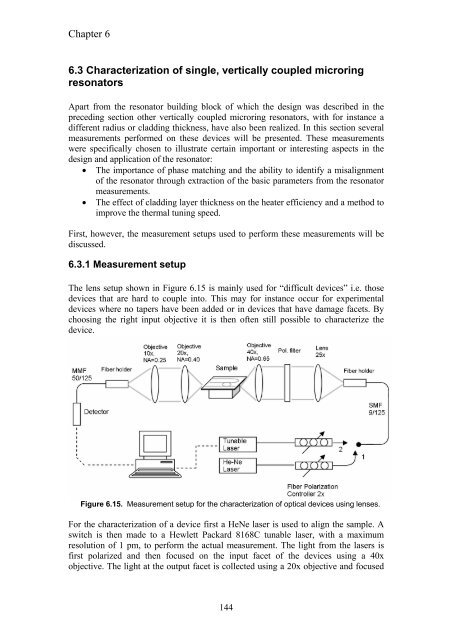Edwin Jan Klein - Universiteit Twente
Edwin Jan Klein - Universiteit Twente
Edwin Jan Klein - Universiteit Twente
Create successful ePaper yourself
Turn your PDF publications into a flip-book with our unique Google optimized e-Paper software.
Chapter 6<br />
6.3 Characterization of single, vertically coupled microring<br />
resonators<br />
Apart from the resonator building block of which the design was described in the<br />
preceding section other vertically coupled microring resonators, with for instance a<br />
different radius or cladding thickness, have also been realized. In this section several<br />
measurements performed on these devices will be presented. These measurements<br />
were specifically chosen to illustrate certain important or interesting aspects in the<br />
design and application of the resonator:<br />
• The importance of phase matching and the ability to identify a misalignment<br />
of the resonator through extraction of the basic parameters from the resonator<br />
measurements.<br />
• The effect of cladding layer thickness on the heater efficiency and a method to<br />
improve the thermal tuning speed.<br />
First, however, the measurement setups used to perform these measurements will be<br />
discussed.<br />
6.3.1 Measurement setup<br />
The lens setup shown in Figure 6.15 is mainly used for “difficult devices” i.e. those<br />
devices that are hard to couple into. This may for instance occur for experimental<br />
devices where no tapers have been added or in devices that have damage facets. By<br />
choosing the right input objective it is then often still possible to characterize the<br />
device.<br />
Figure 6.15. Measurement setup for the characterization of optical devices using lenses.<br />
For the characterization of a device first a HeNe laser is used to align the sample. A<br />
switch is then made to a Hewlett Packard 8168C tunable laser, with a maximum<br />
resolution of 1 pm, to perform the actual measurement. The light from the lasers is<br />
first polarized and then focused on the input facet of the devices using a 40x<br />
objective. The light at the output facet is collected using a 20x objective and focused<br />
144















